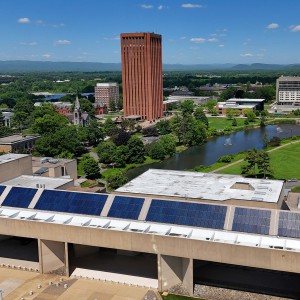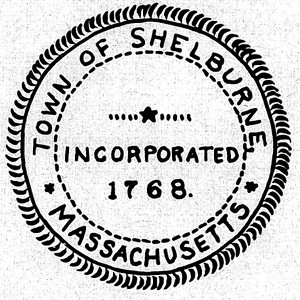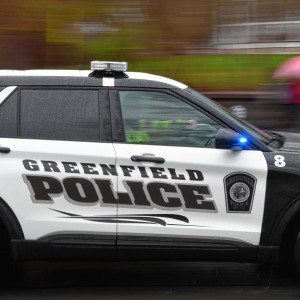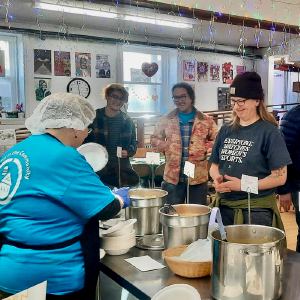Pocumtuck Homelands Festival honors, celebrates Native American cultures of the NE
| Published: 08-04-2024 3:02 PM |
TURNERS FALLS — Vendors, singers and dancers blending centuries of Native American history and culture gathered Saturday in celebration of the 11th annual Pocumtuck Homelands Festival.
The festival takes place at Unity Park, centuries after 300 Native American women, children and elders were killed in a surprise attack by William Turner and a colonial militia in what is now called the Great Falls Massacre of 1676. A Reconciliation Ceremony was held at Unity Park in 2004, bringing an atmosphere of reverence as the community began to better understand what happened during the massacre and its aftermath. Now, Unity Park holds the festival every year to bring people together to honor and remember the Native Americans who died in the Great Falls Massacre.
The festival opened on Friday evening with a traditional Wampanoag dugout canoe called a mishoon leading a group of kayaks, canoes and paddle boards down the Connecticut River, docking out of Barton Cove in Gill. This native practice honors Native ancestors marking the preservation of Native cultures and the conservation of the land.
Approximately 200 people gathered to hear an opening address on Saturday from David Brule, president of the Nolumbeka Project nonprofit that organizes the Pocumtuck Homelands Festival. Brule was accompanied by Justin Beatty, host of the event and a member of the Ojibwe and Saponi tribes. Brule, who is also a member of the Iron River Singers, said the festival brings tribal and nontribal people together aims to recognize the decades of grief associated with the area and to celebrate Native American history and culture.
“It has become something of a ritual tradition for many, many organizations to acknowledge the fact that this is all Indigenous land,” Brule said regarding the Native American history in the area. “We are standing on and benefiting from land that has been indigenous since the last glacier left 15,000 years ago.”
Mohawk elder Tom “Sakokwenionkwas” Porter, a resident of Akwesasne, New York and one of the oldest living members of the Mohawk tribe, talked about the transcendence of Native American culture through many generations. He spoke about the “Creator,” who is known in Native American culture as the creator of the universe.
“Creator is so big and mighty that he is a part of you and me,” Porter said. “So when we hurt each other’s feelings we also hurt Creator.”
Article continues after...
Yesterday's Most Read Articles
 Two dogs, three cats killed in Orange house fire
Two dogs, three cats killed in Orange house fire
 Five UMass Amherst students have visas, student status revoked
Five UMass Amherst students have visas, student status revoked
 Plans to move Northfield EMS to Bernardston property fall through
Plans to move Northfield EMS to Bernardston property fall through
 Shelburne Selectboard determines police detective will retain job
Shelburne Selectboard determines police detective will retain job
 Greenfield Police Logs: March 8 to March 16, 2025
Greenfield Police Logs: March 8 to March 16, 2025
 Lochhead family, aided by Franklin Land Trust, conserves 65 acres in Conway
Lochhead family, aided by Franklin Land Trust, conserves 65 acres in Conway
Multiple speakers and performers took the stage throughout the day, including the Iron River Singers. Beatty explained how the festival has grown since the first years when he started attending. “I’ve been able to see the event grow and see it become a bit more representative of variations of Native groups,” he said.
The Iron River Singers sang multiple songs which Beatty explained are created by singing different syllables at varying pitches, often mistaken as chanting.
“It holds an important place in cultural ceremony … There are many rules that are important to understand,” he said.
While singing, members of the audience danced in what is called “circle and round dancing,” a traditional style of dance expressing individual and tribal identity in which people gather in a circle, holding hands. The circle was led by Jennifer Lee, a vendor and board member of the Nolumbeka Project who identifies with multiple tribes including the Northern Narragansett.
“I heard about the Nolumbeka Project for decades,” Lee explained about how she got involved with the festival. “I really appreciate the work they do so I joined the board … I wanted to know how my native ancestors lived here.”
An array of speakers and performers gathered to share stories passed on from family members, play traditional music and sing. Over 40 vendors lined the park selling food and merchandise from Native American culture including clothes, jewelry, instruments and more.
Lee explained she has a particular interest in bark and wood, the material she uses to craft baskets to sell. She explained that bark is used by Native Americans to insulate warm air inside structures.
Vendor Jaynie Barnes, a member of the Cherokee Tribe, is an artisan gourd crafter for Earth Spirit Designs who makes and sells jewelry, baskets and artwork. The process of carving gourds involves drying the gourds out, cleaning and sanding the pieces which can then be cut and crafted into different shapes. Barnes has a “Three Sisters” garden at home in Greenfield, including gourds. The Three Sisters are known as a trio of crops including beans, corn and squash, grown by many Native American tribes due to their agricultural benefits for one another.
Vendor Wes Pecor Jr., owner of Great Dane Woodworking in Stamford, Vermont, and member of the Massachusett Tribe, sold wood carvings he learned to create from his father. Pecor started as an artist drawing, before discovering wood carving from his carpenter father.
“I only really draw with wood now,” Pecor said. “... My dad was always my biggest fan. You have to have patience to be a wood carver. Now, two of my favorite things are being a parent and wood carving. You need great patience for both.”
The festival included a history tent where stories and lessons were shared.
“Stay away from anything that alters the way the Creator intended you to live,” Porter said regarding advice he would give to young people. “Keep a clear mind the way the Creator intended … This is for older people too. When you talk to your younger people, talk to them like human beings with kindness, love and respect.”
















 Monthly Community Soup Nights prove popular at Greenfield’s Stone Soup Cafe
Monthly Community Soup Nights prove popular at Greenfield’s Stone Soup Cafe
